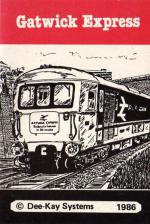Introduction
Gatwick Express is the generic name given to the intense shuttle service introduced in May 1984 between London Victoria and Gatwick Airport. Trains run every 15 minutes for most of the day, working on the push-pull principle with a Class 73 locomotive on one end of the formation and a specially modified driving luggage van (Class 489 GLV) on the other. Stock comprises dedicated rakes of refurbished MkIIf air-conditioned coaches, normally run as six vehicle sets in the winter months and nine vehicle sets in the summer and at peak holiday periods.
In this simulation you are registered to drive the 13.00 hrs Victoria - Gatwick (due 13.30) and the booked return working leaving Gatwick at 13.50 hrs and arriving at Victoria at 14.20. The schedule is demanding on driver concentration, but can comfortably be kept with the available motive power provided you do not experience too many out-of-course events.
Display Format
The simulation is presented as a two-part display on the television screen: the upper section giving information a driver would have from visual observations and his background knowledge of the route, and the lower section being a monitor of the locomotive controls and performance. Milepost distances throughout are expressed in integer tenths of a mile from Victoria.
Route, Speed Restrictions & Signalling
The route used by Gatwick Express trains is via the Quarry Line, and a gradient profile and details of the running schedules are given in the Appendix. The line speed gradually increases from 20 to 55mph between Victoria and Clapham, and is then basically 60mph to Streatham, 70mph to Croydon and 90mph for the remainder of the route. The major exceptions are limits of 50mph at Balham, 45/60mph at Croydon, 80mph at Earlswood and 40mph on the approach pointwork to Gatwick itself. You may also encounter restrictions due to engineering work on the track, and details of these will be given at the start of the simulation. Familiarity with the permitted line speeds will be assumed, although during your run you will be given a reminder 0.5 mile before most major reductions.
The line is signalled with multiple aspect colour lights throughout, which means that there will be a sequence of at least a signal at double yellow and a signal at yellow preceding a signal at red. The distances between signals are typically 0.7 mile, and as such if you are travelling at speed, you will have to brake hard for much of the time under adverse signals to keep your speed under control. All signals at caution or danger trigger a cab warning alarm (AWS), which if not cancelled within 6 seconds will bring an automatic application of the train emergency brake.
Locomotive Controls And Driving Technique
The tractive characteristics of your train are realistically reproduced in the simulation, with both the Class 73 electro-diesel and the GMV assumed to be picking up current from the third rail system.
Power is varied from the driving cab by adjustment of a standard Southern Region d.c. master controller, with four notches (1-4) used respectively for starting off (motors in series with all resistance in circuit - use only in series with resistance gradually cut out), normal operation (motors in parallel) and high speed running (motor field weakening). The higher notches can be selected directly from start, with automatic progression through the various settings under the control of an accelerating relay and wheelslip correction system. To return from a higher to lower notch the controller has to be run-back to the "off" position and then advanced to the desired value - a common operation when travelling at constant speed with the controller alternated between one of the running notches and coasting. Frequent section gaps can result in a rough ride due to the small number of pick-up shoes for current collection, and you are advised to coast over the pointwork on leaving both Victoria and Gatwick (the exit from the latter involving crossing over for the slow to fast lines).
The brake handle is calibrated between 0 (off) and 5 (full on) although position 5 should be used for emergencies only, the maximum application in normal service setting 4. You should brake with caution as you approach adverse signals, and if a signal remains at red you should bring your train to a halt within 35 yds of it in order to obtain telephone instructions from control about the situation. There are controlled signal approach sequences to both Garwick and Victoria, and once in the platforms you should again draw up within 35 yds of either the starting signal or the buffers to be correctly positioned for passengers alighting and boarding.
The computer keys used for locomotive control are:-
| CONTROLLER : | Increase | > |
| Runback | < | |
| BRAKES : | Increase | X |
| Decrease | Z | |
| AWS Cancel : | Space Bar | |
If you want a break during your run, the simulation can be suspended by pressing the H (hold) key, with action restarted by pressing the R key.
Reminder Of Line Manager's Standing Instruction
When trains are running late, drivers must endeavour to make up time with due regard to all speed restrictions and the braking capability of the train.
Schedules
| MP | LOCATION | TIME(DOWN) | TIME(UP) |
| 0.0 | Victoria | dep 13.00 | arr 14.20 |
| 2.7 | Clapham Jnc | pass 13.05 | pass 14.15 |
| 10.5 | East Croydon | pass 13.14 | pass 14.06 |
| 15.0 | Coulsdon North | pass 13.19 | pass 14.02 |
| 21.8 | Earlswood | pass 13.25 | pass 13.55 |
| 26.7 | Gatwick Airport | arr 13.30 | dep 13.50 |










